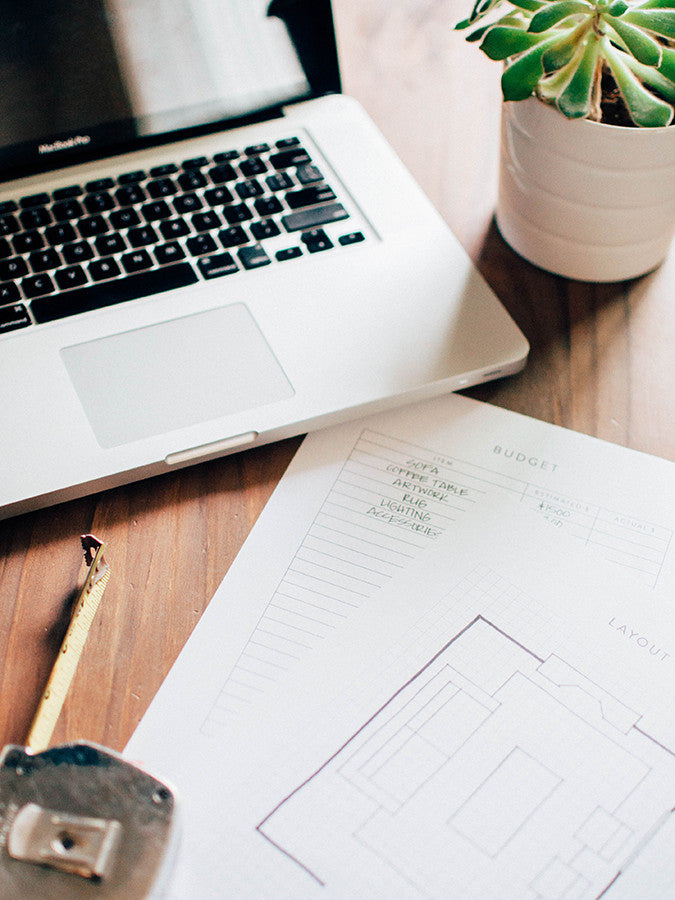
Decorating a room, especially for the first time, can be overwhelming. You know what you like, but you are unsure of how to put it all together. So, I’ve come up with a guide to help you easily decorate your space from beginning to end, and a free worksheet to keep you on track (which can be downloaded at the bottom of the page). Here we go!
1. Inspiration
Before you begin purchasing anything, think about how you want the space to look and feel. Gather inspiration, whether it be images on Pinterest, pages from magazines, fabric swatches, paint chips, or anything else that inspires you. You don't have to be too literal, from a book cover you love, to a branch you found on the beach, anything goes. (Get started by checking out some inspiring spaces on my Pinterest boards.)
Once you have a great collection of inspirational pieces, take a look and try to find some common themes throughout the items you’ve accumulated. Take note of similar styles, colors, patterns, motifs, and materials. By doing this you can better understand what it is you love about all of your inspiration pieces, and create a cohesive concept to weave throughout the space.
2. Details
In order to design a space that works for your lifestyle, you need to determine how you need this room to function. Who will be using this space? How many people does it need to accommodate? How will it be used? What do you already love about it? What isn't working for you?
3. Inventory
Take some time to assess what you already have in the space. What works? What needs to go? Categorize each piece into one of four categories: keep, refurbish (paint, refinish, reupholster), donate, or sell. Be sure to measure the items you are keeping for when you create your layout in the next step. Also think about scouting the rest of your house for pieces that might work in this space.
Where to donate: The Slavation Army, The Goodwill, Habitat for Humanity
Where to sell: Craigslist, Ebay, Move Loot, Close 5
4. Layout
Use graph paper (or the layout page in the worksheet) to draft the walls, windows, doors, and any other architectural details in the room, then play around with the placement of the items you will be keeping. By doing this you will see where you still have holes you need to fill, which will help you determine what you still need for the space. Try different layouts until you find one that works for you.
Related Post: Furniture Layout Dimensions To Remember
5. Budget
Once you have a basic layout down you can start deciding how to fill those holes, and how much you are willing to spend. A few items to think about when determining your budget:
-
Paint/wall treatments
-
Rugs
-
Furniture
-
Window treatments
-
Lighting
-
Accessories
Create a list of what needs to be purchased and allocate money from your budget to each item. You can also use this sheet to keep track of what you actually spend to help you stay under budget.
6. Research and Finalize
With your budget set and shopping list in hand it's time to start researching. In the worksheet I list many of my favorite sources for home decor in various price points for you to reference. Keep a visual board of everything you are considering for the space so you can see how the pieces work together. You can do this with Pinterest, photoshop, or an actual bulletin board.
7. Installation
You’ve come up with a concept, decided what to keep, locked down a layout, set a budget, and finalized the design, now its time to make it happen. Create a list of everything that needs to get done to complete the space, adding a due-date if that will help you stay on track. This will keep you organized and help you complete your project with ease.
Now that you've got the gist, download the free worksheet below and get started on your next decorating project.
Click here to download the worksheet.
© 2016 Jaymee Srp. For personal use only.
Do you have any good decorating tips or tricks? share in the comments!

Subscribe to our newsletter:
